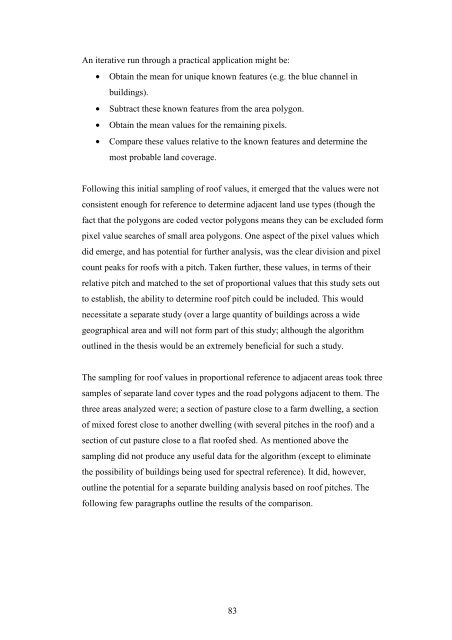You also want an ePaper? Increase the reach of your titles
YUMPU automatically turns print PDFs into web optimized ePapers that Google loves.
An iterative run through a practical application might be:<br />
• Obtain the mean for unique known features (e.g. the blue channel in<br />
buildings).<br />
• Subtract these known features from the area polygon.<br />
• Obtain the mean values for the remaining pixels.<br />
• Compare these values relative to the known features and determine the<br />
most probable land coverage.<br />
Following this initial sampling of roof values, it emerged that the values were not<br />
consistent enough for reference to determine adjacent land use types (though the<br />
fact that the polygons are coded vector polygons means they can be excluded form<br />
pixel value searches of small area polygons. One aspect of the pixel values which<br />
did emerge, and has potential for further analysis, was the clear division and pixel<br />
count peaks for roofs with a pitch. Taken further, these values, in terms of their<br />
relative pitch and matched to the set of proportional values that this study sets out<br />
to establish, the ability to determine roof pitch could be included. This would<br />
necessitate a separate study (over a large quantity of buildings across a wide<br />
geographical area and will not form part of this study; although the algorithm<br />
outlined in the thesis would be an extremely beneficial for such a study.<br />
The sampling for roof values in proportional reference to adjacent areas took three<br />
samples of separate land cover types and the road polygons adjacent to them. The<br />
three areas analyzed were; a section of pasture close to a farm dwelling, a section<br />
of mixed forest close to another dwelling (with several pitches in the roof) and a<br />
section of cut pasture close to a flat roofed shed. As mentioned above the<br />
sampling did not produce any useful data for the algorithm (except to eliminate<br />
the possibility of buildings being used for spectral reference). It did, however,<br />
outline the potential for a separate building analysis based on roof pitches. The<br />
following few paragraphs outline the results of the comparison.<br />
83
















